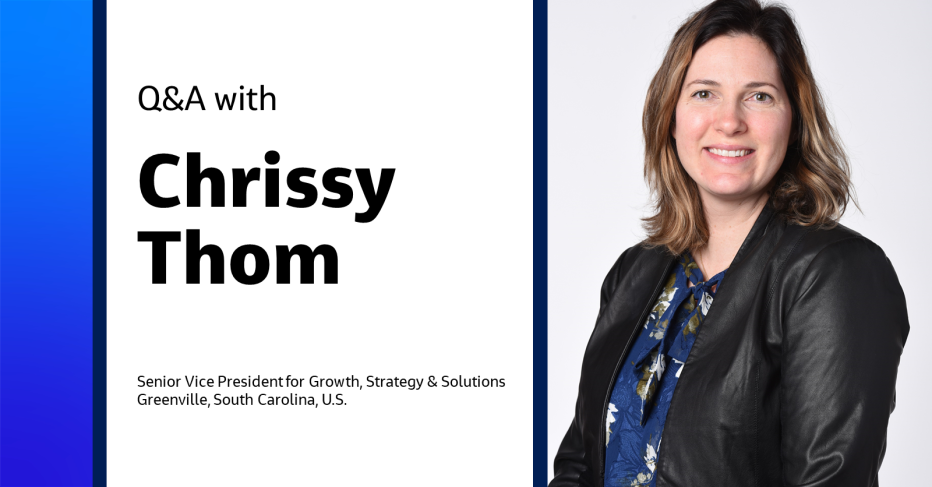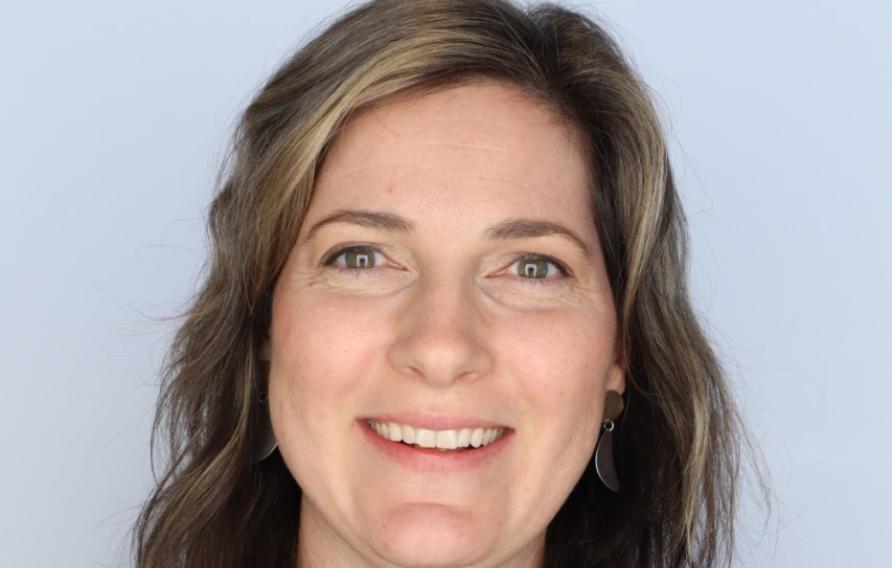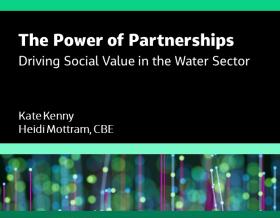
Transportation and utilities infrastructure are going to be hot sectors for next several years and discovering and implementing the next generation of tools for understanding current state and expected life, as well as planning new work and tracking repairs, is going to be key to delivering success. Chrissy Thom recently took to the stage at the leading technology forum, Engineering News-Record (ENR) FutureTech, to discuss how data-led solutions are better informing transportation and infrastructure investments and programs.
Tell us a little bit about yourself and your career with Jacobs so far.
Over my career, I’ve made many stops, starts and pivots along the way. It didn’t start out this way, but now I see my superpower as spotting the patterns in disparate areas and innovating solutions out of the chaos — something that’s rooted in my training as an Ecologist.
As I deal with challenges I frequently draw from my technical experiences, from researching watershed management and infrastructure improvements, to piloting an airboat through coastal marsh communities in my early days. I’ve learned so much about the different cultural connections to the places, lands and planet we call home and that’s greatly influenced how I engage as a leader.
There’s another side to my career journey as well: recognizing I have a valuable contribution to make as a woman in a male-dominated industry. I grew up knowing I wanted to build the future in a meaningful way, though I didn’t feel I had the natural leadership instincts to achieve this. But through the science and some really good role models along the way, I began to test the boundaries of my strengths — a lot of the time I’d fall short on my ability to communicate a vision and inspire a team to think differently. But the more I tested and included different perspectives and expertise, the better I got at getting to the right solutions. This is why I am so committed to STEAM outreach and mentoring talent across a diverse set of backgrounds and experiences, particularly those from under-considered and under-represented backgrounds, to achieve the most innovative outcomes.
As a result of this perseverance, and through maximizing my personal strengths, in 2020 I was honored to take the lead on a cross-market strategy to rapidly address our clients’ emerging challenges. This plan and set of investments have propelled our innovation and resilience to a new level, ensuring we’re able to equip clients to respond to the challenges and opportunities heading their way. Taking on this challenge was scary but so rewarding. And while the dynamics continue to shift, I’m proud to continue to drive our technology investments in a proactive way to clear the way for the future.
What’s your favorite part of your role?
Getting to see how advancements in digital technologies can truly modernize essential infrastructure across our communities. From climate change to aging networks and shrinking budgets; states, cities and municipalities are facing complex, multifaceted challenges. As an example, in 2021 climate change disasters cost the world over $100 billion, escalating the need to protect communities against climate threats. Similarly, the pressure to fast-track our decarbonization efforts gets stronger every day, with the transport sector alone accounting for 25% of our greenhouse gas emissions. Try addressing all of this when, in the U.S. alone, we have an infrastructure investment gap of $2.6 trillion.
But right now, the combination of the U.S. infrastructure stimulus and breakthrough innovation means we have a generational opportunity to futureproof our infrastructure in an affordable and equitable way. It’s a pivotal time for the industry, and I believe it’s truly exciting.
What are some of these generational opportunities you talk about and how can we make these a reality?
In this new era, resilient infrastructure should be designed to both protect what we have, move people and goods where they need to be, and distribute the benefits equitably and cost effectively. Across sectors, digital solutions and data analytics are delivering more informed, efficient and effective infrastructure decisions and investments.
As an example, we can now use “new normal” traffic data to prioritize transportation infrastructure projects. We can apply advanced data analytics to identify optimal electric vehicle (EV) charging locations and develop more convincing business cases. And we can use remote data collection to enhance the efficiency and safety of maintaining our water networks. These are just some of the ways big data is transforming our ability to deliver more with less.
“Right now, the combination of the U.S. infrastructure stimulus and breakthrough innovation means we have a generational opportunity to futureproof our infrastructure in an affordable and equitable way. It’s a pivotal time for the industry, and I believe it’s truly exciting.”
How are digital tools having most impact on project delivery?
I’m seeing impact in three key areas. Firstly, in creating resilient, sustainable infrastructure, digital tools can help optimize existing networks affordably and reduce the need for new grey infrastructure.
Secondly, they’re helping clients leverage data to unlock funding. What we’re hearing is that agencies have fragmented data systems, outdated and limited capability, and poor data quality providing little insights. New technologies help agencies make better use of data to increase competitiveness for funding, like that released through the Infrastructure Investment and Jobs Act (IIJA). It’s enabling them to quickly understand current state and demonstrate impact after a project is complete.
Lastly, alongside cost and schedule, clients want their projects to enhance sustainability, social equity and inclusion and interconnectedness — and there are tools that can help them quantify this. This supports clients’ environmental, social and governance (ESG) commitments, addresses heightened public expectations for corporate citizenship and enables them to meet government funding criteria where creating social value is increasingly a prerequisite.
The electrification of the transport sector is a current hot topic. How is tech changing the game for transportation?
In the U.S., 200+ transit agencies are already operating, ordering or have received funding for zero-emissions vehicles.
However, it’s abundantly clear that the challenge to decarbonize is not just about procuring the EVs or battery-electric buses (BEBs). We need to put the infrastructure in place to support fleet, including planning charger locations, innovating the types of charging available and scaling up power to support electric fleets and transit networks. These requirements all present a multitude of challenges.
As an example of how big data can help, we’re currently developing an EV infrastructure deployment plan for one of the largest states in the U.S. to unlock funding from the U.S. Department of Transportation’s (DOT) National Electric Vehicle Infrastructure Formula Program. This entails using digital tools from StreetLight, a pioneer of mobility analytics and part of the Jacobs portfolio, to identify optimal locations for charging infrastructure and to ensure that the funds are distributed equitably, meeting Justice40 requirements. This creates a comprehensive, data-backed plan and a competitive grant application.
Another example is the delivery of a pilot inductive charging road for Michigan DOT, to help electric buses ‘top off’ their charge as they drive and achieve longer service routes. The pilot, delivered as part of a consortium led by Electreon, serves as a proof-of-concept for transit and service fleet owners seeking to solve challenges with current charging methods, including range anxiety.
Leveraging tech such as these is enabling clients to ensure the investments they're making today will support the transportation systems of the future.
Beyond transportation, what other next generation tools did you share at ENR FutureTech?
Amidst strained resources and a future talent crisis, the digital transformation of our water sector continues to be critical to enhance the efficiency, safety and resilience of utility operations. I see technology breaking ground in two key areas, including smart sewers and automated condition assessments.
Let’s start with smart sewers. By introducing smart technology and sensors into the wastewater network, utilities can understand how their systems are performing in real time, alerting operators to potential incidents and avoiding damaging spills, floods, blockages and discharges, which are harmful to their customers and our environment. Aqua DNA is a game-changing digital product that collects live data using smart sensors and AI-powered predictive analytics, to reduce risk and make a positive societal and environmental impact. The seamless collection and analysis of thousands of data points enables Aqua DNA to proactively recognize operational patterns and identify conditions that lead to incidents, ultimately reducing external flooding by 14%, pollution events by 20% and blockages by 13%, not to mention the increases to operational efficiency.
Secondly, while today’s processes are well established, they tend to be reactive, manually intensive and prone to errors, which results in inconsistent data. DragonFly is an AI-powered condition assessment and guidance tool to cost-effectively manage collection system infrastructure. It allows utility operators to review inspection video while it analyzes and provides prescriptive guidance on how best to maintain these buried assets, enabling issues to be identified before they become problems.
With exposure to an ever-increasing range of hazards, risks and threats, infrastructure managers need to be able to anticipate the future and prioritize spending to optimize the benefits. How can digital tools be utilized to support resilience?
Resilient, sustainable infrastructure requires a connected solutions approach. Analytics and technology must be part of all phases of investment, right through from securing funds, planning and design to operations and maintenance.
In the face of rapid urbanization and climate variability, Kaleidoscope is a predictive analytics solution that enables managers to rapidly identify vulnerabilities across multiple infrastructure networks and environmental scenarios. Previously, managers may have lacked the visibility across departments to accurately assess the risks of any given place or city block, but now there is visibility to prioritize capital expenditures and achieve greater infrastructure resilience, helping to curtail expensive, unplanned and reactive maintenance.
In the planning and design phase, digital twins such as Replica allow solutions to be investigated and tested without putting equipment, public health or the environment at risk. These realistic simulations of facility behavior allow organizations to assess “what if” scenarios in the digital domain and solve for some of the most perplexing challenges, before they can occur — enhancing system understanding and achieving improved system design, optimized operations performance and reduced capital and operating costs.
Finally, Climate Risk Manager is one of our latest data-analysis tools helping infrastructure managers to make more informed decisions. Integrated with best-in-class Intergovernmental Panel on Climate Change (IPCC) sanctioned datasets and a state-of-the-art climate hazard scoring algorithm, the cloud-based platform helps organizations understand the impacts of climate change and quickly and accurately assess, plan and invest against immediate and future climate risks to both current and planned assets. By rapidly mapping across an entire operational and value chain base, the platform provides organisations with a holistic understanding of climate risk and exposure, together with the power to take action to mitigate and adapt to future risk. After all, when it comes to climate risk, knowledge is power.
Digital transformation is ultimately a people issue. How do clients create the culture to drive transformation across their operations?
The work of adapting to the massive changes that go along with integrating technology into any agency or business falls to everyone. It’s about being courageous about doing things differently — and it doesn’t always happen on the first try.
We can foster dynamic collaboration and innovation by empowering colleagues at all levels to bring the best of their skillsets to the table. It’s about setting the right conditions for an agile culture, adopting an open mindset and being willing to accept new ways of working and technology. Importantly, colleagues should be provided with appropriate upskilling opportunities to lean in and learn in different ways. Many agencies I’ve worked with have garnered great support through partnering employees with next generation tech skillsets with colleagues with more seasoned traditional engineering skillsets.
It’s through this approach that we’ve quickly broken ground in the EV battery manufacturing market. Through cultivating talent and broadening their skillsets to support the projects we have in this space; we’ve grown an integrated team of more than 600 people from 17 different time zones. It’s an exciting time for everyone involved. What we’ve learned is that success happens when we set the expectation of an ‘open source’ mindset for how we work with our clients, industry partners and employees. This is the groundswell needed to change critical infrastructure delivery.
What advice would you give to tech-savvy young professionals thinking of joining Jacobs?
My advice is to consider why and consider what’s possible. At Jacobs, what we do is more than a job, we work every day to make the world better for all. Everything we do — from addressing water scarcity and aging infrastructure to ensuring access to life-saving therapies and protecting against sophisticated cyberattacks — is more than projects outlined in proposal requests. We know we can help our partners make a positive impact on the world. Each of us is united by the drive to dream big.
About the interviewee

Chrissy Thom is Senior Vice President of Growth, Strategy & Solutions at Jacobs where she leads a global team working to unlock true global intelligence for clients across the company’s buildings and infrastructure portfolios. With a technical background in Biology, Chrissy was always drawn to science as a means of service and the art of the possible in how we create a better world.
You might be interested in...
-
 Showcase
ShowcaseMeet Chrissy Thom
Chrissy Thom oversees our Environmental market, working with clients and inspiring our talent to develop solutions that reinvent tomorrow every day. With every action, she never loses sight of Jacobs trusted reputation for delivery excellence.
-
 News
NewsJacobs Acquires Mobility Analytics Leader StreetLight Data, Inc
Jacobs announced today it has acquired StreetLight Data, Inc. ("StreetLight"), a pioneer of mobility analytics who uses its vast data and machine learning resources to shed light on mobility, enabling users to solve complex transportation problems. The addition of StreetLight accelerates Jacobs' strategy in growing its end-to-end digital solutions portfolio and focus on ESG, while adding high growth, highly recurring revenue software businesses that offer tremendous value for its clients and the communities they serve.
-
 Solution
SolutionClimate Risk Manager
Climate Risk Manager is a cloud-based platform brings together global climate data and location intelligence, giving you visual risk assessments, so you can make faster and more accurate decisions on where to invest limited resources and guard against climate risks.
-
 Solution
SolutionKaleidoscope
Kaleidoscope is a cloud-based, platform-as-a-service application offering an easy-to-understand, big-picture approach to decision-making perfectly suited to help improve cross-disciplinary collaboration.
-
 Solution
SolutionReplica
Replica is Jacobs' digital twin solution software platform, delivering intelligent solutions for our customers around the world for more than 20 years.
-
 Solution
SolutionDragonfly
Dragonfly efficiently provides the accurate data and AI-driven recommendations your team needs to optimize decision-making and refine your system management and intervention strategies.


















































